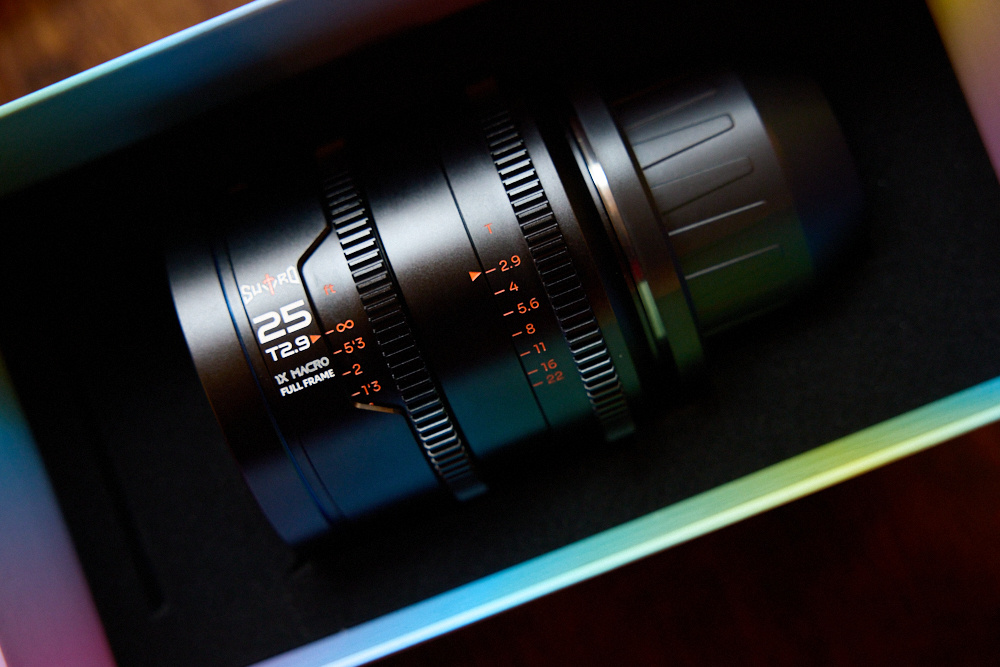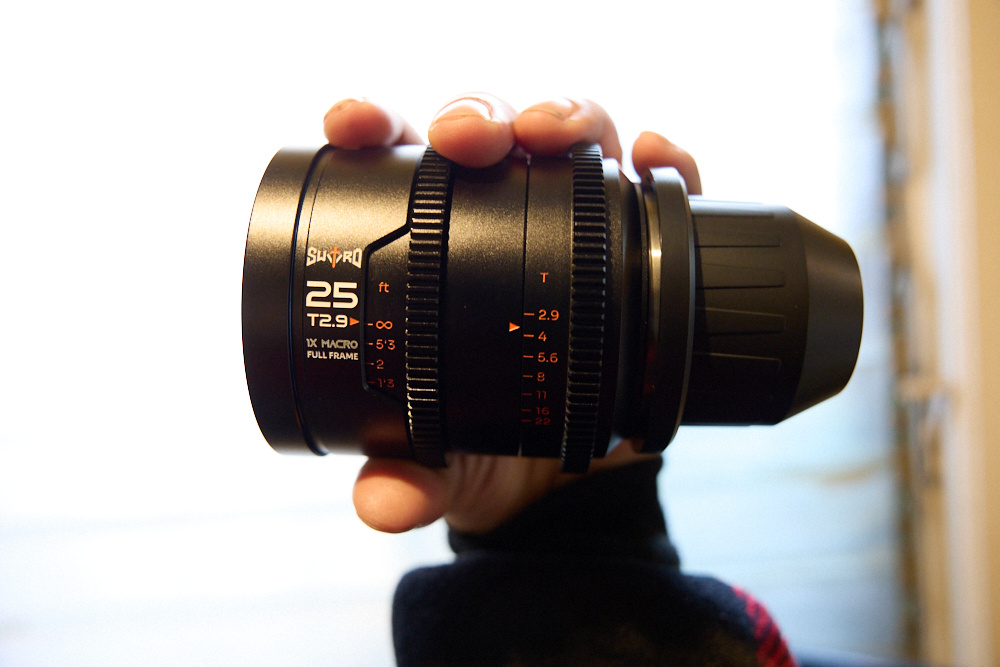Today, Laowa has introduced a new line of cinema lenses to the cinematography market. And these have a major perk: macro capabilities.
Picking the perfect lens has always been the most important part of any film project. Are you picking for clarity or character? Are you going anamorphic or spherical? What is your subject, and what is the correct tool to capture the action?
If you’ve read my reviews in the past, you’ll know that I’m not big on specs. But there is one spec when it comes to lenses that is unavoidable: What is the minimum focusing distance? Depending on the shots you wish to obtain, having a lens with a short minimum focusing distance can mean the difference between getting the shot or not. While there is a litany of amazing cinema lenses on the market, the percentage of those with the ability to focus hyper close is limited. The number of macro lenses, the ultimate in close-up detail shots, is even more limited. Generally, most filmmakers have had to resort to diopters to magnify their miniature subjects. But the option to use a macro lens, common in the photography world, is not always so easy or affordable for filmmakers to access.

Today, Laowa has sought to address that issue as it releases a new line of cinema macro lenses it is calling the Laowa Macro Sword FF Cine Series. The series currently consists of six focal lengths. They include:
- 15mm T4.1 (1x magnification)
- 25mm T2.9 (1x magnification)
- 35mm T2.9 (1x magnification)
- 60mm T2.9 (2x magnification)
- 100mm T2.9 (2x magnification)
- 180mm T4.6 (1.5x magnification)
The lenses vary in terms of aperture. They are light in design: 640 grams at the low end with the 15mm. The heaviest is the 100mm T/2.9 at 957 grams. They are all capable of at least a 1:1 reproduction ratio, with the 60mm and 100mm going as high as a 2:1 reproduction ratio. The lenses are full frame and cover a 43.2 mm image circle.

1st ACs will appreciate that all the lenses in the line have a uniform follow focus pitch. This makes it easy to swap lenses between takes, as both the barrel widths and gear placement are identical across the line, preventing the need to adjust the placement of your follow focus throughout the day. For such micro-detail work often associated with macro lenses, having a longer focus throw (larger barrel) might actually be an advantage for obtaining critical focus. But in my testing, I had no issues obtaining sharp images and really appreciated the lightweight design, which I believe solo shooters will appreciate.

Aside from the 15mm, which has a 95mm filter thread, the rest of the lenses in the line have a standard 77mm filter thread size. By default, they come in a standard ARRI PL mount, which was the unit I tested. There are optional mounts for Canon RF, Canon EF, Sony E, Nikon Z, and L-mount users as well. (Note: At the moment, there is no EF mount for the 25mm.) Each lens comes with a set of shims if you need to make additional adjustments.

The highlight of the lens set is their minimum working distance. I was able to get so close to my subjects during testing that I was almost touching them.
Minimum Working Distance
- 15mm = 0.7 cm
- 25mm = 2.14 cm
- 35mm = 3.2 cm
- 60mm = 5.9 cm
- 100mm = 8 cm
- 180mm = 14.2 cm


The lenses are all manual focus. Like most lenses, especially macro, they sharpen up as you stop down. I tested each lens wide open and at different apertures and found them to be plenty sharp for my taste. Chromatic aberration wasn’t overly noticeable in any of the units I tested. I got to test three lenses from the line: the 25mm, 60mm, and 180mm.

One thing I’m always interested in with macro lenses is how they function in general, non-macro situations. To that end, I took each lens and did a walkaround test to see if these lenses could pull double duty to shoot a regular scene with the perk of being able to move in close when needed. Again, the lenses all performed up to the task relative to my expectations. I wouldn’t say you’ll never need another lens again, but I would say that using a lens like the 25mm for general-purpose filmmaking with the potential to do macro work is a real possibility, especially given the lens's small form factor.

The build structure of the lenses accounts for their size and weight. The 15mm has 12 elements in 9 groups. The 25mm and 35mm have 13 elements in 10 groups. The 60mm has 14 elements in 11 groups. The 100mm has 12 in 10. And the 180mm has 12 in 9. Compared to other competing cinema lenses, the set is decidedly smaller.
If you want to use these as general-purpose lenses as well as macro lenses, it’s worth having a look at the bokeh. Opening the three lenses I tested all the way and throwing a light bulb in the background out of focus, here’s what I got: The 60mm and 180mm at their widest apertures (T2.9 and T4.6, respectively) had relatively rounded bokeh. The 25mm at T2.9 displayed more hexagonal bokeh when wide open.



Pros
- Small size
- Lightweight
- Price
- Matching 77mm filter thread size (except the 15mm)
- Matching barrel width and placement of the focus gears for easy changing
- Minimum focusing distance
- Minimum operating distance
- Consistent look across the line
- Can perform as traditional lenses as well
- Full frame
Cons
- Like most macro lenses (or general-purpose lenses, for that matter), you’ll want to stop down a bit to get them sharper
- Medium focus throw (could also be a plus depending on your workflow)

All in all, I found this to be a very useful set of prime lenses for video production. The macro functionality allows filmmakers to get closer to their subjects and bring out specific details of the scene without additional equipment. And the lightweight design and relatively reasonable cost make them both usable and obtainable for filmmakers looking for solid results at a reasonable price.
Each lens retails for $1,499 USD sold separately. There is also a 4-lens kit with the 25mm, 35mm, 60mm, and 100mm for $5,699 USD. The full set will set you back $7,999 USD.







This is really great news for me, even though these are not lenses that will work for me.
Why?
Because minimum focus distance and magnification capabilities have too long been ignored as important specs in "normal" lenses.
For decades, I have had to use lenses specifically designed as macro lenses in order to shoot small things close-up. But seeing that Laowa is including macro capability in lenses that can function as all-around cinema lenses is encouraging. Especially so the 15mm, as macro ability and ultra wide angle have not been two things that come together in the same lens until very recently.
Also encouraging is the fact that Tamron and Sony have both released half-macro capabilities in zoom lenses within the past two years. Hopefully, it will soon become normal for all lenses to have pretty good close-up capabilities, and we will see the maximum magnification ratio and minimum focus distance be something that lensmakers feel pressured into improving all across their entire lens lineups.
I look forward to seeing "macro" being used together with the words "zoom" and "wide angle" in the coming years, and lenses like those written about here are going to pave the way for that to become more commonplace.